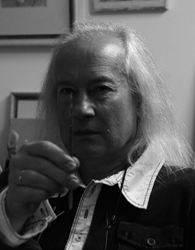The Surrealism and Abstractionism of Dreams.
Alexander Vorobyev's voice of originality speaks about dreams, struggle and conflict, politics and ideology, nature and the absurd. Considered a master of surrealism and abstraction Vorobyev has been compared to Dali, Miro, Ernst, Kandinsky, Filonov and Kalmykov. He breaks through into new worlds reflective of our own with renewed meaning conjured out of juxtaposition of make-believe with the real, reflective of psychology and the forces and events that work upon it.
Over many years Vorobyev has experimented with his dreamscape and ideas to create powerful works that display a calculated compositional approach yet seem to flow with automatism. The viewer journeys around his works, always finding new meanings the deeper you look. His canvases are a complex mix of texture and forms which display his unique symbology.
Following the surrealist tradition Vorobyev's use of animal symbols are prevaliant throughout his work, with terrapins, snails, bats, horses and insects often intertwined with human forms. There is a fascination with shapes and broad use of plains of textured colour. Vorobyev's works show his preoccupation with machines, which turn up as small drawings reminiscent of Da Vinci or as the working parts of mechanical characters. Typography is also prominently used; letters and words, sometimes whole written sentences are present within and surrounding his works.
Many of Vorobyev's works carry religious symbolism; 'A cross to me is the most powerful and beautiful symbol. It is not only the cross Christ was crucified on. The cross is my childhood again – with crosses of window frames of old houses, masts of ships, it is a handle of a sword, medieval Europe, crusaders, a razor blade, it is a battle, a struggle of the vertical and horizontal lines, of the spiritual and the material worlds.' (Alexander Vorobyev)
Vorobyev refers to Artur Rimbaud's comment 'irregularity of thought is sacred' – it is through this pilgrimage with his stream of consciousness that Vorobyev breaks through to the other side of perception and new meanings are delivered through his master works.



